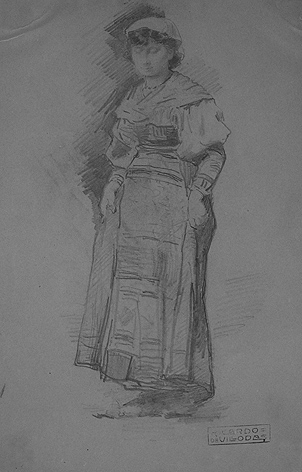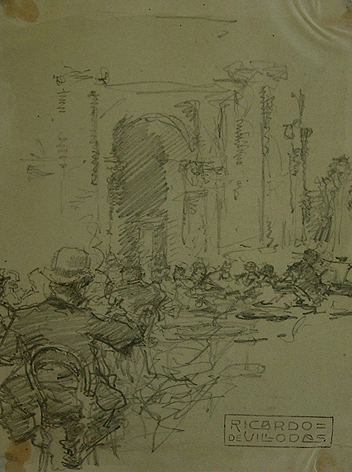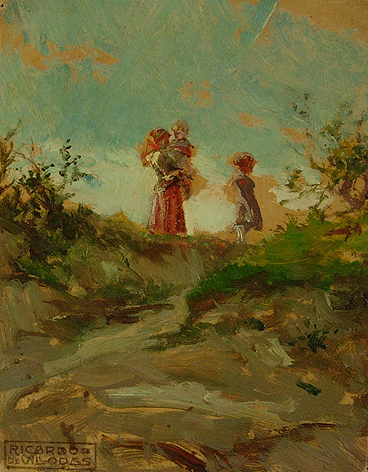The piece of the month of December 2008
THE ALBUM OF DRAWINGS BY RICARDO VILLODAS DE LA TORRE
Amaya Alzaga Ruiz. Professor of Art History at UNED.
José Luis Requena Bravo de Laguna. Chair of Heritage and Navarrese Art.
Among the still scarce collection of antique and 19th century drawings at the Library Services of the University of Navarra is an important album containing a collection of 53 unpublished drawings by the Madrid painter Ricardo Villodas de la Torre (Madrid, 1846 - Soria, 1904) from the generous bequest of Don Luis Moya Blanco (Madrid, 1904 - 1990), a personality core topic in post-war Spanish architecture and former professor at the School of Architecture of the University of Navarra.
This album of drawings by Villodas, the most important so far known, is an interesting contribution to the study of the unique phenomena of nineteenth-century drawing collecting in Spain and, above all, offers a testimony of the way of proceeding of a great draftsman, unjustly forgotten by current historiography, during his long stay in Rome.
The Album of drawings by Ricardo de Villodas, presents elegant covers lined in gray percaline with the following title engraved in relief: "DIBUJOS ORIGINALES / DE / DE / RICARDO DE VILLODAS". Once opened, we can see two period flyleaves that protect the 33 unpaginated black cardboards on which the different drawings are adhered. The materials used by the author include charcoal, chalk, pencil and ink. The unsigned drawings are stamped with the seal of the painter's will, made after his death.

Fig. 1. La Ciocciora, pencil, 21.8 x cm.
Ricardo de Villodas began his training at the age of fourteen at the San Fernando School of Fine Arts in Madrid, where he was student of Federico de Madrazo, Alejandro Ferrant and Carlos Luis de Ribera. Despite family reticence to his artistic vocation, he completed his first training copying the masters of the Prado Museum and attending the study of Rosales. In 1864 he obtained the Third Medal at the Regional exhibition of Zaragoza for his canvas El Niño italiano, which earned him favorable reviews and a trip to Paris at programs of study . He remained in the City of Light for twelve years, interacting with the artistic colony of Spaniards established there, periodically visiting the workshops of Raimundo de Madrazo, Leon Bonnat and Eduardo Zamacois. Along with the influence of the tableautins with genre scenes that the latter practiced, Villodas again completed his training by copying large history paintings in Parisian museums.
In 1876 he returned to Madrid, obtaining that year the medal of second class in the National exhibition for his praised work The Death of Caesar, despite his obvious dependence on Rosales. Two years later, his painting Mensaje de Carlos I al Cardenal Cisneros ( 1517) (Museo del Prado, on deposit at the Albacete City Hall) deserves the same distinction and praise, which he will also exhibit at the Universal exhibition in Paris in 1878. Encouraged by the successes obtained, he decided to move to Rome without institutional economic support, where he remained for twenty years. In order to broaden his knowledge training he attended the popular Academia Chigi and the classes given by Casado del Alisal at the Academia de España, he frequented the workshop of Lorenzo Vallés and the crowded cenacle of José Villegas Cordero. His most important work of those years is Victuribus gloria o Naumaquia en tiempos de Augusto (Ayuntamiento de Soria), an ambitious Pompeian composition that he sent to Madrid, where he obtained the first medal class in the National exhibition of 1887 and that will bring him international fame.
Villodas combined in Rome the internship of the academic painting of History, indispensable on the way to the longed-for official consecration, with numerous easel works of anecdotal subjects. Along with themes of classical antiquity such as Figura Pompeyana, in his studio on the Via Margutta he produced costumbrist works, house paintings, in the orbit of Meissonier, Zamacois and Fortuny or orientalist themes. Unfortunately, part of Villodas' Roman work was lost in the fire at the customs house of the Mediodia station where the seven paintings he sent to the National exhibition in 1882 were deposited. Economic reasons forced his return to Spain, where he received the support of Alfonso XII, who bought his work El leñador and named him Knight of the Royal Order of Carlos III. In 1889 he was distinguished with medals in the exhibitions of Paris and Munich, settling until his death in Soria, practicing his last years the portrait, landscape, a painting of saints inherited from the Baroque tradition and genre paintings influenced by social realism finisecular, more fluid brushstroke. He also illustrated the work En Roma: escenas y cuadros, written by Andrés Mellado, whom he would portray years later as governor of the Bank of Spain.

African subject , charcoal, 20.5 x .5 cm.
The following is a thematic tour that will help us to evaluate the collection of drawings as a whole. Beginning with the most numerous group , dedicated to the portrait genre, a group of heads stand out for their impeccable skill technique, executed in Indian ink and in pen and ink, which are among the most A of Villodas' production on paper. The first of them, Portrait of D. Giovanni Vittorio presents the singularity of being the only one dated -1890- of the whole Album. Unfortunately, up to now it has not been possible to identify the personage due to the incomplete transcription of the text that accompanies the drawing. Another portrait, that of Francesco Lutini, bears the name of the small Roman municipality of Cineto Romano. Curiously, both names are related to an extraordinary event that occurred in that area in the early hours of August 1872 when a medium-sized meteorite caused a spectacular roar that woke up the peaceful locals. One of the witnesses, a noble peasant named Francesco Lutini, portrayed in two drawings by Villodas, collected a fragment of the meteorite in the grounds of his property, in Piano Agostinello, which is currently exhibited in one of the showcases of the Observatory of the high school Romano. Along with these drawings, two portraits of a scholar seated in an interior consulting some books and numerous young women posing or depicted delicately in their intimacy stand out for their quality, along with portraits of children, all works of touching tenderness.
The second most important group of drawings is sample , with several sketches from life of typical characters of the Roman countryside, among which a beautiful Cioccior, drawn in pencil, stands out. These regional types are related to the watercolors of Types of the province of Burgos that he drew in Spain. Scenes of theaters and open-air cafés frequented by elegant characters of the first Roman Belle Époque or religious celebrations developed among sketched interior architectures also abound. All these scenes constitute what critics at the time called "themes of the day".
Fortuny's influence is evident in the orientalist exoticism of two Arab characters and in another pair of drawings "de casacón" whose models are dressed in the fashion of the House of Austria.
The allegorical female figures, dressed according to Pompeian fashion, the male academies and the female nudes constitute an interesting group whose value lies in their function as academic preparatory drawings for other compositions.

Coffee Scene, pencil, 12.7 x .5 cm.
We cannot end this brief tour without mentioning the delicate oil on cardboard representing a country scene, so closely linked aesthetically to the impressionist and luminist currents of the landscape a plein air, a sketch of the natural with a loose brushstroke that incorporates some costumbrist figures in the background.
This album of drawings shows us the freer side of a painter who gained recognition during his lifetime thanks to a painting of an ample and theatrical history, today largely forgotten. In contrast to the exaggeration of the gestures and the hackneyed brushstrokes, we find in this Album the loose strokes of a draughtsman who portrays from life Roman characters and types, the immediacy of urban life, the precision of the features of some characters portrayed with photographic detail, far from the rigors of the Academy.
The authors are grateful for the invaluable financial aid provided by María Calonge and Belén Galván, librarians of the Archive of the University of Navarra for the study of the Album of Ricardo de Villodas.

Fig. 5. Country scene, oil on cardboard, 14.9 x .5 cm.
Selection of drawings from the album by Ricardo Villodas:
Fig. 1. La Ciocciora, pencil, 21.8x14 cm.
Portrait of a scholar in his studio, ink, 21.1x16 cm.
Fig. 3. Study of mother and son, albayalde, charcoal and ink, 23,5x30,5 cm.
Fig. 4. Swordsman, ink, 22,3x14 cm.
Fig. 5. Country scene, oil on cardboard, 14,9 x ,5 cm.
Fig. 6. Africansubject , charcoal, 20,5 x ,5 cm.
Fig. 7. Ecce Homo, ink, 14.8 x .2 cm.
Fig. 8. Study of two women dancing, charcoal, 18.4 x .3 cm.
Fig. 9. Female nude, charcoal, 25.4 x .8 cm.
Fig. 10. Portrait of a girl, ink, 18.5 x .2 cm.
Fig. 11. Coffee Scene, pencil, 12.7 x .5 cm.
Fig. 12. Crying boy, ink, pencil and white lead, 15.9 x .8 cm.
Portrait of Francesco Lutini, 1890, ink, 10.5 x .4 cm.
Fig. 14. Hunter, charcoal, 7.4 x cm.
Fig. 15. Academy, charcoal and white lead, 19.9 x .5 cm.
bibliography
- Painted artists. Portraits of painters and sculptors of the 19th century in the Prado Museum. Catalog exhibition Madrid, Ministry of Education and Culture, 1997, pp. 152-153.
- One Hundred Years of Painting in Spain and Portugal (1830-1930). Volume 11. Ed. Antiquaria, Madrid, 1993, pp. 303-305.
- GONZÁLEZ, C. and MARTÍ, M., Spanish Painters in Rome (1850-1900). Tusquets, Barcelona, 1987, pp. 235-236.
- GONZÁLEZ, C. Y MARTÍ, M., Spanish Painters in Paris (1850-1900). Tusquets, Barcelona, 1989, p. 285.
- OSSORIO Y BERNARD, M., Galería Biográfica de artistas españoles del siglo XIX. Madrid, Ed. Giner, 1975, p. 700.
- PANTORBA, B., Historia y crítica de las exposiciones nacionales de bellas artes celebradas en España. Ed. 1980, p. 497.
